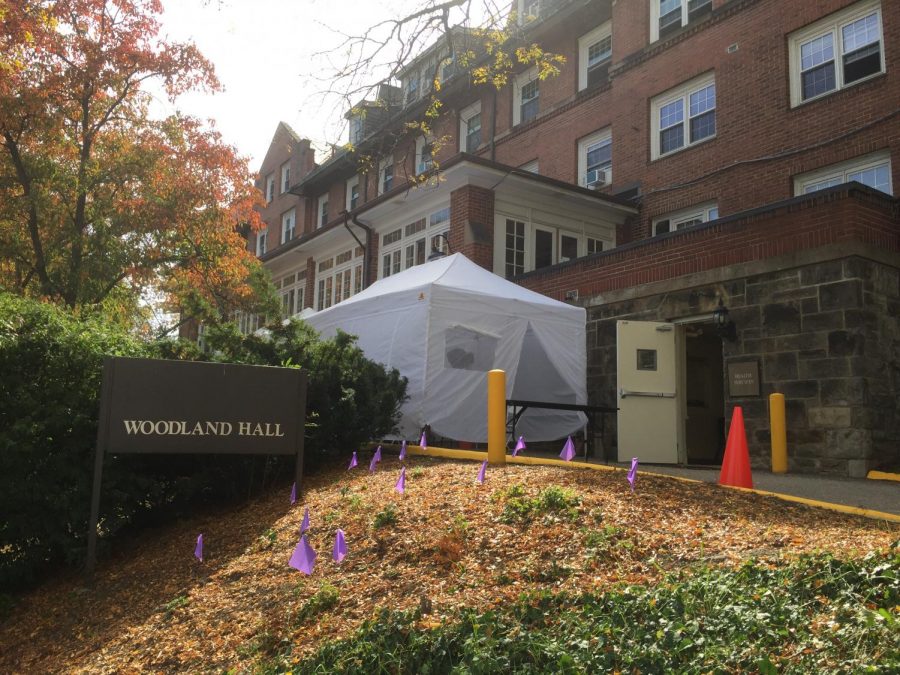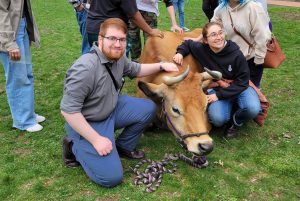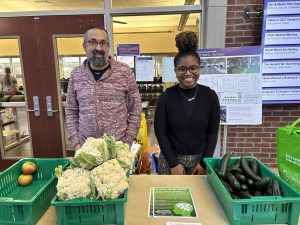What it’s like to get a COVID-19 test at Chatham University
The white tent where tests are administered is near Woodland Hall and next to Health Services. Credit: Alice Crow
October 16, 2020
A familiar white tent is set up on the small sidewalk area just outside of Woodland Hall. Underneath the tent is a white folding table and a sign-in sheet filling up with signatures. A masked nurse in light green scrubs wields the nasal swab of a student sitting in a chair. The swab is handed through a window at the completion of the procedure, and the student leaves to make way for the next person.
This is a snapshot of what getting a COVID-19 test at Chatham University’s Shadyside campus looks like. Earlier this semester, the University has rolled out a plan for random-sample testing for various groups on campus.
As of Oct. 16, 761 students have received antigen tests on campus, with 41 positive results. Nineteen of these positive cases were commuter students, and 22 of them were students who live on campus. No Chatham employees have tested positive to date.
Because of the recent spike in positive cases, the University announced in an email Oct. 16 that it would shift to a virtual delivery format beginning that evening through Oct. 25.
The test Chatham students receive is an antigen test. A mucus sample is taken to detect proteins on the surface of the virus. The rapid test results can be received in about 15 minutes. The RT-PCR molecular test detects for pieces of the virus itself by looking for its genetic material.
Annette Muller, the Health Services practitioner and one of the lead swabbers, said that a new test for Chatham students is in process.
“It is a little more sensitive,” Muller said, “even though the antigen test currently in use has a 97/98% sensitivity rate and positive tests are pretty accurate.”
Muller heads the five-person team that makes this all work. Three team members who take turns doing the actual swabbing are students.
“They sought out doing this,” Muller said. “They are outstanding workers. Patient, knowledgeable and compassionate.”
Muller said that students who show up to be tested may be feeling sick or scared or questioning what to do. Again and again, her team strives to calm the nerves of fearful arrivals.
I wasn’t a randomly selected student for testing, but instead I self-scheduled my appointment by phone. Questions were asked of me before my appointment time was assigned: Was I in close contact? Was I symptomatic? What were my symptoms?
The sign-up process is simple, with information accessible on Chatham’s website or by calling 412-365-1714. Appointments must be made in advance.
A student was being tested as I signed in and filled out a small information sheet. Clean pens were on the left, used pens on the right. A man came out of the Health Services office door to assure my place in line.
It was a cool morning, but I didn’t have to wait long. The nurse invited me over to the chair and explained the procedure.
I would be having a mid-nasal swab, she said as she held up what looked like a Q-tip. She would insert the swab halfway up my nose and hold it there for 15 seconds.
“You may sneeze or your eyes might tear up,” she said, which explained the nearby box of tissues.
Prepared to sneeze, I tilted back my head. The first 15-second swab test went quickly. The nurse swabbed the second nostril, then handed my sample in a plastic bag through the window above my head, and I was on my way.
What happens behind the window? The test swabber hands the tubed and bagged sample to the test runner, who immediately starts processing it. Saline is administered to a white disc in the bottom of the tube.
That tube is swirled as the saline breaks down the disc below the mucus sample. After sitting for one minute, a pipette is used to extract the liquid. The liquid goes into a hole in a cartridge, which sits on top of a test strip. Once the cartridge is put into the testing machine, a plus or minus is detected in 11 seconds.
If a test comes up positive, the contact tracking team jumps into action. The test-positive person is notified, and instructions are given to isolate or self-quarantine. A contact list is gathered in order to identify those who were in close proximity. Phone calls are made to set up testing for them, if needed.
Speed and protecting the sample are key. The window was put in place to streamline the process of passing off the sample from the swabber to the test runner. Everyone is masked, gloved and shielded, further protecting the sample as well as each other.
Students are normally asked to wait nearby for the test result. The day of my test, I was asked to wait in my car. It was an unusually busy morning, I was informed, and it was easier to maintain physical distancing if those who had been tested returned to dorms or cars. (It also was a warmer place to wait on a fall day.)
Twenty minutes later, I received my phone call. Negative. In my experience, the whole process was handled with efficiency, compassion and privacy.
Muller welcomes student input to make modifications for a better experience. The University tracks its testing on an online dashboard that’s updated each Tuesday and Thursday.







